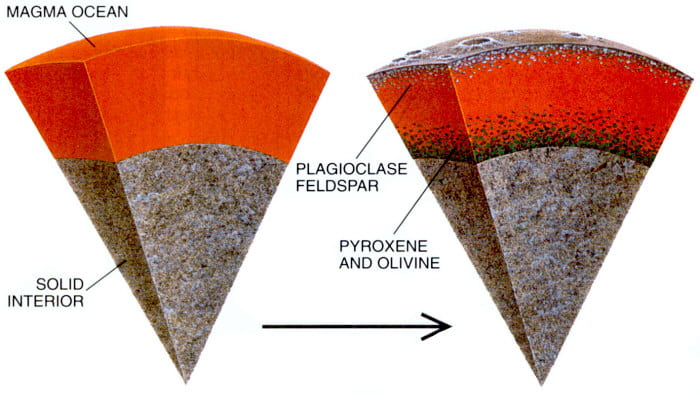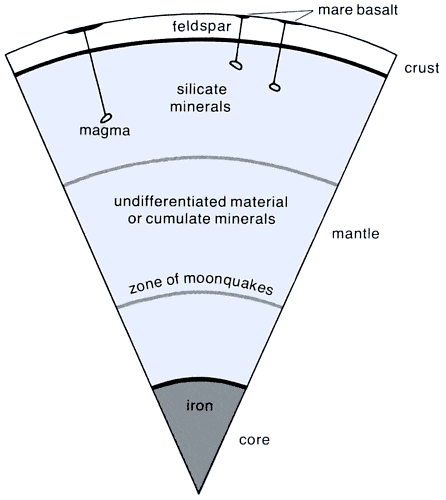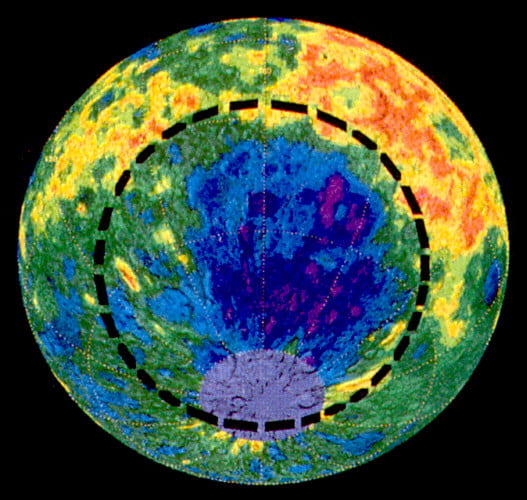The Moon has been visited by twelve Apollo astronauts during missions in the late 1960’s and early 1970’s, and by numerous robot spacecraft. A total of ~382 kg of samples were returned by the Apollo missions, and and additional 321 g of samples returned by three Russian Luna robot spacecraft. There are also several meteorites on Earth that are of known lunar origin. Below is a summary of lunar geology gleaned from several references, cited below.

The solar system began as an extended, low-density cloud of cold interstellar dust and gas. Under the influence of its own gravity it began to collapse into a smaller, denser cloud. As the cloud became smaller and denser, random motions of the gas and dust resolved themselves through gas friction and possibly magnetic interactions into net spin. The collapsing cloud took on the shape of a rotating disk, dense along its midplane (top left). Disk rotation represents the net angular momentum of the original cloud. The central portions of the disk were hottest and densest, and at some point thermonuclear fusion in the center permitted the new sun to shine with its own light. Farther out, bits of dust collided and stuck together into increasingly larger clumps. These clumps continued growing to boulder, asteroid, and larger sizes. The larger bodies had sufficient gravitation to disturb the orbits of other nearby bodies, promoting orbit crossings and frequent collisions, from which still larger bodies formed. The last stages of planetary accretion involved giant collisions of planet-size bodies. The end result is our own solar system with the planets in regular, more or less stable orbits (bottom right). This cartoon illustrating accretion of the planets from a dust and gas disk to our current planetary system is from Figure 3 of Ahrens (1994).
The later stages of planetary collision, as mentioned above, involved giant impacts. Computer modeling and geocemical evidence suggests that the Moon was likely created during an oblique collision of a body, perhaps the size of Mars, with the proto-Earth. The impact threw enough material into Earth orbit to form the Moon. Most of this material was from the silicate mantles. The orbiting material originally would have formed a temporary ring around the Earth. Initially this material was very hot, probably including considerable rock liquid and vapor. Easily volatalized materials probably would have been lost from the ring to space, explaining why the Moon is so depleted compared to the Earth in water, CO2, arsenic, sodium, and other easily volatilized components. This collision also explains the anomalously low iron content of the Moon (tiny iron core, because most of the ejected material was silicate mantle), and the anomalously high angular momentum of the Earth-Moon system. This representation of the giant impact that threw the material for the Eoon into Earth orbit is from Taylor (1994, cover photo).
Magma ocean and differentiation

The ejecta blasted into Earth orbit by the hypothetical giant impact was very hot. As it coalesced to form the Moon, some of this initial heat and release of gravitational potential energy probably allowed much of the early Moon to be liquid. Some models suggest that a magma ocean hundreds of kilometers deep initially covered the Moon. As heat radiated away to space, the magma ocean slowly crystallized. Low-density minerals like plagioclase floated to form the plagioclase-rich anorthositic highlands crust. High-density minerals like pyroxenes, olivine, and Fe-Ti oxides sank to form part of the lunar upper mantle. The lunar lower mantle, shown here as mottled brown and gray, is a region that may never have been largely molten. This simple magma ocean concept omits complications such as a protracted episode of lunar accretion, and solid-state mantle convection. Many post-accretion impacts were very large and doubtless disrupted the crust and upper mantle, also complicating the simple structure and lithology shown here. This image is from Taylor (1994). Note that the presence of a small iron core has been omitted from this diagram.

After crystallization of the magma ocean, there were still supplies of magma in the Moon, including residual interstitial liquids, melting caused by heat from radioactive decay, and possibly decompression melting induced by mantle convection. Melting produced basaltic magmas that, because of their lower density than surrounding rocks, moved upwards to the surface to erupt as basaltic lava. These lavas mostly filled large asteroid impact basins that are mostly on the near side of the Moon. The dark color of the lavas suggested to early observers that these regions were seas, or maria in Latin. The iron core makes up perhaps 1 to 3% of the lunar volume; 2 to 6% of its mass. Tidal stresses apparently cause the Moonquakes that generally occur at a depth of ~1000 km. These quakes are very small by terrestrial standards. Seismic S waves apparently do not traverse the region below the zone of Moonquakes, suggesting that this material has very low shear strength, possibly containing some liquid. Not shown here are the effects of possible solid state convection in the Moon’s mantle (e.g., Figure 4 of Papike et al., 1998). This schematic illustrates the sources of upper mantle magmas that rose to flood large impact basins with basaltic lavas. From Figure 2 of Taylor (1987).

At least some lunar volcanic eruptions produced glass spheres, such as the orange glass spheres seen in the sample disk. These spheres are thought to have been formed during lunar fire fountain activity, with liquid droplets quenching to glass during their ballistic trajectories from the vent to the ground. Some glass spheres were doubtless also from impact liquids, possibly including the white and green spheres found in the lunar soil. Droplets on the Moon have considerably more time to fall than droplets in similar trajectories on the Earth, because of the much lower gravitational acceleration. This schematic shows a lunar volcanic vent and fire fountain. The magma sources were deep in the Moon, and magma rises to the surface because its density is lower than the surrounding rocks. High eruption velocities at the surface were probably driven by magma gas expansion. From Meyer (1987).
Topography and other maps

This topographic map of the Moon shows several interesting features. First, the near side of the Moon (right half of the map) is, on average, at lower elevation than the far side (left half). The near side also has thinner lunar crust, has most of the lunar maria, and has most of the mare basalts. The low areas (blue) are the floors of large impact basins. Mare Orientale is the green spot just south of center. Mare Crisium is the dark blue spot in the far right. The large blue patch on the lower left is the South Pole-Aitken basin, the largest known impact basin in the solar system at 2500 km across and 12 km deep. This basin is scarcely visible in photographs because it is so ancient and so overprinted by more recent craters of various sizes. From Figure 2 of Zuber et al. (1994).

Free air gravity anomaly map of the Moon. This shows gravity anomalies, corrected only for a low-resolution geoid surface. That is, the gravity field in this map is uncorrected for medium and small-scale topography. The gravity highs are caused by uplifted mantle rock below basin floors, and by the filling of the basins by dense mare basalts. From left to right the three prominent, aligned red spots in the upper right are Mare Imbrium, Mare Serenitatis, and Mare Crisium. The blue ring is Mare Orientale. From Figure 2 of Zuber et al. (1994).

This is a Bouguer gravity anomaly map of the Moon. This map is like that above, but the gravity field has been adjusted to remove topographic effects. It therefore gives a better idea of the regional rock structure that is responsible for the gravity anomalies, whereas the free air gravity map above shows the gravity field caused by both structure and topography. This shows that there is dense rock beneath the surfaces of most of the mare basins, especially the giant South Pole-Aitken basin on the lower left. From left to right the three prominent aligned red spots in the upper right are Mare Imbrium, Mare Serenitatis, and Mare Crisium. From Figure 2 of Zuber et al. (1994).

This crustal thickness map was made from the gravity anomaly map assuming constant density of the lunar crust and upper mantle at any given depth. The calculated crustal thickness ranges from nearly zero beneath Mare Crisium to 107 km in the lunar highlands, especially on the lunar far side. The average crustal thickness in this model is 64 km, ~11% of the lunar volume. Average far side crustal thickness is 68 km, and near side crust is 60 km. Again, this crust is thought, in a general sense, to be anorthositic and to have been related to plagioclase floating to the top during crystallization of the magma ocean. From Figure 2 of Zuber et al. (1994).

Southern topography showing the South Pole-Aitken Basin, the largest known impact basin in the solar system. The basin has a rim diameter of 2500 km and a floor-to-rim elevation difference of up to 12 km. It was excavated by a large impact. The initial crater was probably at least 1000 km in diameter and 120 km deep. It is therefore likely that the lunar upper mantle was exposed by this impact. From Spudis et al. (1994).
Table 1. Lunar minerals, adapted from Table 3 of Meyer, 2003.
| Mineral | Formula | Plane-light appearance | Type |
|---|---|---|---|
| Major phases | |||
| Plagioclase Pyroxene Olivine Ilmenite | CaAl2Si2O8, rather little NaAlSi3O8 (Ca,Mg,Fe)2Si2O6 (Fe,Mg)2SiO4 FeTiO3 | Colorless Pale-brown Colorless to faint-green Opaque | Silicate Silicate Silicate Oxide |
| Minor phases | |||
| Iron Troilite Ulvöspinel Chromite Spinel Armalcolite | Fe FeS Fe2TiO4 (Fe,Mg)Cr2O4 (Mg,Fe)(Al,Cr)2O4 (Mg,Fe)(Ti,Zr)2O5 | Opaque Opaque Opaque Opaque Opaque Opaque | Metal Sulfide Oxide Oxide Oxide Oxide |

Apollo (red), Luna (yellow), and Chang’e (blue) sample sites. This full Moon image clearly shows the two major surface types: bright highlands composed mostly of feldspathic plutonic rocks, and dark mare composed of dark basaltic lavas that flowed onto the Moon’s surface, filling low-lying impact basin floors. Samples from the NASA thin section set come from all of the Apollo sites except Apollo 11. This image is from Lick Observatory.
Table 2. Apollo’s influence on lunar science (adapted from Taylor, 1994).
| Topic | Pre-Apollo view | Current view (my understanding as of ~2021) |
|---|---|---|
| Origin | Captured, derived from the Earth, or formed with the Earth as a dual planet. | Giant impact on the proto-Earth, followed by formation of the Moon from ejected debris. |
| Craters | Most impact, some volcanic. | Almost all impact. Few volcanic features have substantial craters. |
| Presence of volatiles such as water | Unknown, although some scientists thought water once flowed on the Moon's surface. | Mostly very dry, but water brought in by impacting comets is apparently trapped in very cold, perpetually shadowed craters at the poles. |
| Rock ages | Uncertain, but probably ancient (more than a few billion years). | Highlands: most rocks older than 4.1 billion years, with anorthosites 4.4 billion years. Maria: some as young as ~2 billion years, others as old as 4.3 billion years. |
| Magma ocean | Not conceived of. | Anorthosites formed from a magma ocean; other highland rocks formed after that. |
| Maria composition | Unknown. | Wide variety of basalt types. |
| Highlands composition | Unknown. | Wide variety of rock types, but most containing more aluminum (mostly in plagioclase) than do mare basalts (e.g., generally anorthositic). |
| Mantle composition | Unknown, but probably like Earth's? | Varying amounts of mostly olivine and pyroxene. Some parts containing substantial Fe-Ti oxides. |
Cited references
Ahrens, T.J., 1994, The origin of the Earth. Physics Today, August, p. 38-45.
Meyer, C., 2003, The Lunar Petrographic Educational Thin Section Set: Planetary Materials Branch, Solar System Exploration Division, NASA, 66 p. (This booklet accompanies the thin section set.)
Papike, J.J., Ryder, G., and Shearer, C.K., 1998, Lunar samples. Chapter 5, p. 5-1 to 5-234, in Papike, J.J., ed., Planetary Materials, Mineralogical Society of America, Reviews in Mineralogy, v. 36.
Spudis, P.D., Riesse, R.A., and Gillis, J.J., 1994, Ancient multiring basins on the Moon revealed by Clementine laser altimetry: Science, v. 226, p. 1848-1851.
Taylor, T.J., 1987, The origin of the Moon. American Scientist, v. 75, p. 469-477.
Taylor, G.J., 1994, The scientific legacy of Apollo. Scientific American, v. 271, no. 1, p. 40-47, and cover photo.
Zuber, M.T., Smith, D.E., Lemoine, F.G., and Neumann, G.A., 1994, The shape and internal structure of the Moon from the Clementine mission: Science, v. 266, p. 1839-1843.
Also see:
Washington University, lunar meteorites page
Wikipedia: Geology of the Moon
USGS geologic map of the Moon
Lunar and Planetary Science Institute

